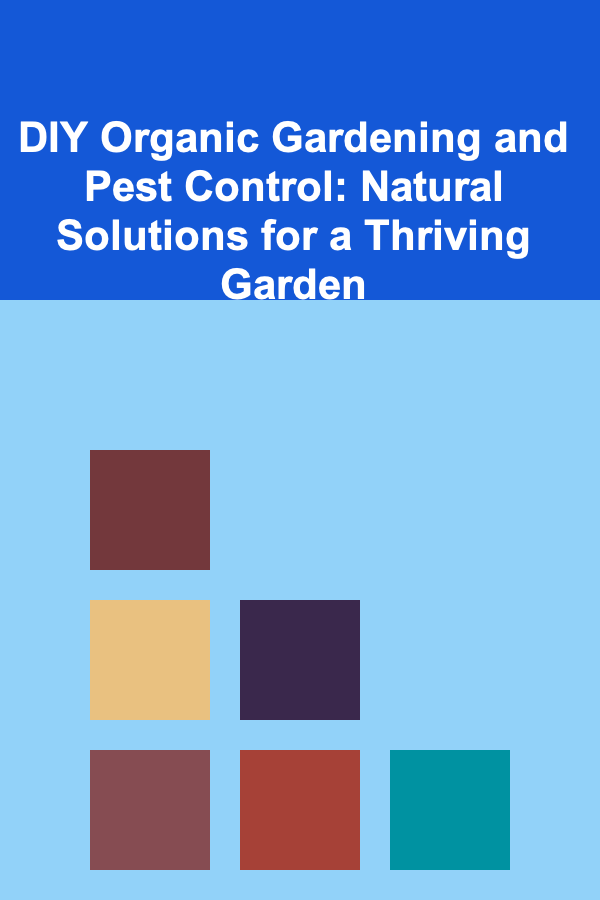
DIY Organic Gardening and Pest Control: Natural Solutions for a Thriving Garden
ebook include PDF & Audio bundle (Micro Guide)
$12.99$5.99
Limited Time Offer! Order within the next:

Organic gardening is not just a trend---it's a movement towards sustainability, health, and environmental responsibility. By growing your own food organically, you not only reduce your carbon footprint but also take control of what goes into your soil and food. One of the major aspects of organic gardening is managing pests without the use of harmful chemicals. Instead of turning to synthetic pesticides, organic gardeners embrace natural solutions that encourage a healthy ecosystem and a thriving garden.
This guide will explore actionable, natural techniques for both creating and maintaining an organic garden, along with tips on how to deal with pests using eco-friendly methods. Whether you're a seasoned gardener or a beginner, these practices will help you build a resilient, productive garden without relying on harmful chemicals.
Understanding Organic Gardening
Before diving into pest control, it's important to understand the foundation of organic gardening. Organic gardening focuses on maintaining soil health, promoting biodiversity, and using natural methods to nurture plants. It aims to create an ecosystem in your garden where beneficial organisms, such as earthworms, bees, and predatory insects, thrive.
Key principles of organic gardening include:
- Soil Health: Organic gardening emphasizes building healthy, living soil. This is achieved through the use of compost, mulching, and crop rotation.
- Biodiversity: Organic gardens thrive on diversity, with a variety of plants, insects, and animals working together to create a balanced environment.
- Sustainability: Organic gardening focuses on sustainable practices, avoiding synthetic chemicals, and reducing environmental harm.
By maintaining a healthy and diverse garden ecosystem, you can naturally reduce the need for pest control.
Preparing Your Organic Garden
The success of your garden starts with its foundation---healthy soil. When your soil is rich in nutrients and teeming with beneficial microorganisms, plants are more likely to resist diseases and pests. Here are steps to help you prepare your organic garden:
2.1 Soil Preparation
- Test Your Soil: Understanding your soil's pH and nutrient levels is the first step to improving its health. You can purchase soil testing kits or send samples to a local extension service for analysis. Based on the results, amend your soil with compost, organic fertilizers, or other soil amendments.
- Add Compost: Compost is the cornerstone of organic gardening. It provides nutrients, improves soil structure, and encourages beneficial microorganisms. You can make your own compost using kitchen scraps, yard waste, and other organic materials, or buy it from local suppliers.
- Mulch: Apply a 2-3 inch layer of organic mulch (such as straw, wood chips, or shredded leaves) to conserve moisture, suppress weeds, and keep the soil temperature stable.
2.2 Choosing the Right Plants
Select plants that are well-suited to your climate and growing conditions. Native plants, in particular, are adapted to local pests and diseases and require fewer resources to thrive. Companion planting, or planting certain species together to benefit each other, can also help reduce pest problems and improve plant health.
Natural Pest Control Methods
In organic gardening, the goal is not to eliminate all pests, but to create a balanced ecosystem where harmful pests are controlled naturally. By promoting biodiversity, attracting beneficial insects, and using organic pest control methods, you can manage pests without harming the environment.
3.1 Encourage Beneficial Insects
Beneficial insects are natural predators of garden pests. These include:
- Ladybugs: Ladybugs are voracious consumers of aphids and other small insects. You can attract ladybugs to your garden by planting nectar-rich flowers such as dill, fennel, and yarrow.
- Lacewings: Lacewing larvae feed on aphids, caterpillars, and other soft-bodied insects. Planting marigolds, cosmos, and zinnias can help attract lacewings.
- Predatory Beetles: Ground beetles and rove beetles are excellent at controlling soil-dwelling pests such as slugs and root-feeding insects. Providing mulch and ground cover will create a habitat for these beneficial beetles.
- Parasitic Wasps: These tiny wasps parasitize and kill pest insects such as aphids, caterpillars, and whiteflies. They are best attracted by plants like sweet alyssum and dill.
3.2 Use Natural Pesticides
When pests become overwhelming, consider using natural pesticides. Unlike synthetic pesticides, which can harm beneficial insects and disrupt ecosystems, natural pesticides are safe for the environment.
- Neem Oil: Neem oil is an effective and organic solution for controlling a variety of pests, including aphids, mites, and whiteflies. It works as both an insecticide and a fungicide, disrupting the pest's lifecycle and preventing further damage.
- Insecticidal Soap: Made from natural fatty acids, insecticidal soap can be used to treat soft-bodied pests like aphids, spider mites, and mealybugs. It works by breaking down the pest's outer protective layer, causing dehydration and death.
- Diatomaceous Earth: This fine powder is made from the fossilized remains of tiny marine organisms. It works by cutting into the exoskeletons of insects, causing them to dry out and die. Apply diatomaceous earth around the base of plants and on leaves to target pests like ants, snails, and slugs.
- Garlic and Chili Pepper Spray: A homemade mixture of garlic, hot pepper, and water can act as a deterrent for many pests. The strong odor and taste of the garlic and chili pepper repel insects, making them less likely to damage your plants.
- Horticultural Oils: These oils can be used to control a variety of pests, including aphids, mealybugs, and scale insects. Horticultural oils suffocate pests without harming the plants.
3.3 Physical Barriers
Sometimes, physical barriers are the best way to keep pests at bay. These are effective in preventing damage without using any chemicals.
- Row Covers: Lightweight, breathable fabric can be draped over plants to protect them from pests like aphids, caterpillars, and flea beetles. Row covers also help keep plants cool and shield them from frost.
- Copper Tape: For slug and snail control, copper tape can be placed around plant pots or along garden beds. The copper creates a mild electrical charge that deters these pests from crossing.
- Sticky Traps: Yellow sticky traps are effective at attracting and trapping flying insects like aphids, whiteflies, and fungus gnats. Place them near plants that are prone to pest infestation.
3.4 Encourage Pest-Repellent Plants
Certain plants are known to repel pests due to their strong odors or chemical properties. Incorporating these plants into your garden can help reduce the need for pesticides.
- Marigolds: Marigolds are known to repel nematodes, aphids, and whiteflies. Planting them around vegetable crops can help protect your plants.
- Basil: Basil not only enhances the flavor of your meals but also repels mosquitoes, aphids, and other insects. Planting it near tomatoes, peppers, and other herbs is a win-win.
- Mint: Mint repels ants, aphids, and mosquitoes. However, it's best to plant mint in containers as it can spread quickly and take over your garden.
3.5 Crop Rotation and Companion Planting
Crop rotation and companion planting are two fundamental techniques for maintaining a healthy, pest-free garden.
- Crop Rotation: Avoid planting the same crops in the same spot each year. This helps prevent the buildup of soil-borne pests and diseases that target specific plants.
- Companion Planting: Some plants naturally repel pests when grown together. For example, planting garlic or onions near your carrots can help deter carrot flies, while planting marigolds alongside your tomatoes can prevent nematode infestations.
Maintaining Garden Health for Long-Term Pest Prevention
The key to a thriving organic garden is maintaining a healthy, balanced ecosystem. By focusing on soil health, promoting biodiversity, and using integrated pest management techniques, you can reduce the need for chemical interventions and enjoy a productive, pest-free garden.
Here are a few tips for maintaining garden health:
- Keep Soil Fertile: Regularly add compost to enrich the soil with nutrients and support plant health.
- Mulch to Retain Moisture and Suppress Weeds: Mulching helps keep the soil moist and prevents weeds from competing with your plants for resources.
- Water Wisely: Overwatering can lead to fungal diseases, while underwatering can stress plants and make them more vulnerable to pests. Use drip irrigation or water at the base of the plants to avoid wetting the foliage.
- Monitor Your Garden Regularly: Keep an eye on your plants for any signs of pest or disease problems. Early intervention is key to preventing widespread damage.
Conclusion
Organic gardening and pest control are not only sustainable but also create healthier environments for both gardeners and the surrounding wildlife. By focusing on natural solutions such as encouraging beneficial insects, using organic pest control methods, and maintaining garden health, you can grow a thriving garden that's free of harmful chemicals.
The beauty of organic gardening is that it allows you to work in harmony with nature, creating a balanced ecosystem where your plants, the soil, and the pests all play a role. By implementing these eco-friendly practices, you'll not only grow better food but also contribute positively to the environment for future generations.

How to Continuously Improve Your Customer Retention Strategies: A Checklist for Long-Term Growth
Read More
How to Curate a Capsule Wardrobe with Luxury Pieces
Read More
How to Make Your Home a Great Place for Multiple Pets
Read More
How to Use Task Lighting in the Kitchen for Safety and Efficiency
Read More
Unlocking Free Accommodation: A Comprehensive Guide to Work Exchange Programs
Read More
Navigating Legal Requirements for Startups: A Comprehensive Guide
Read MoreOther Products

How to Continuously Improve Your Customer Retention Strategies: A Checklist for Long-Term Growth
Read More
How to Curate a Capsule Wardrobe with Luxury Pieces
Read More
How to Make Your Home a Great Place for Multiple Pets
Read More
How to Use Task Lighting in the Kitchen for Safety and Efficiency
Read More
Unlocking Free Accommodation: A Comprehensive Guide to Work Exchange Programs
Read More